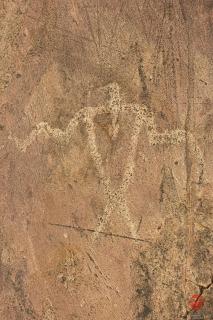Hallowed Ground and Hard Stone

The earliest carvings at Jeffers Petroglyphs (Minnesota) were created 7,000—9,000 years ago.
"I remove my shoes because this is hallowed ground," the guide says. "A holy place, not an everyday life place." The guide tells us how we know—or think we know—it was the one and not the other for those people millennia ago. But aren’t the places where we live holy ground? Don’t our very acts of feeding one another, healing one another, singing to one another, teaching one another, dancing together and weeping together hallow the places where we live?
"This is an early morning image," the guide says, spritzing it with water so we can see it on a cloudy afternoon. "Shifting light through the hours and the seasons reveals different images." Isn’t that the way it is with the images of our lives? That the signs and symbols, events and turning points and decisions, telling the stories of our days and years come into clarity and fade again through cycles of light and dark, seasons of birth and growth, hibernation and death?
"This stone is hard," the guide says. "Harder even than granite. So hard that the snows and rains and winds of thousands of years have not erased marks left by the glaciers of the last ice age." Yet the buffalo wore one tall rock smooth, rubbing away their irritations against it, ’til it shone like glass. Isn’t even this the way of our lives? That flesh and blood can find relief in rough places? That irritants can polish us? That hard will sometimes yield to soft after countless repeated encounters?
| Author | Lisa Doege |
|---|---|
| Date added | |
| Tagged as |